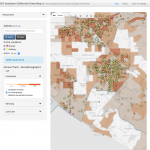
In the Southern California Crime Study (SCCS), we made an effort to contact each police agency in the Southern California region and request address-level incident crime data for the years 2005-2012. Many of the agencies were willing to share their data with us. As a consequence, we have crime data for 2,740 of the 3,852 tracts in the region, which cover 219 of the 341 cities and 83.3% of the region’s population.
The data come from crime reports officially coded and reported by the police departments. We classified crime events into 6 Uniform Crime Report (UCR) categories: homicide, aggravated assault, robbery, burglary, motor vehicle theft, and larceny. Crime events were geocoded for each city separately to latitude–longitude point locations using ArcGIS 10.2, and aggregated to various units such as blocks, block groups, and census tracts. The average geocoding match rate was 97.2% across the cities, with the lowest value at 91.4%. These data have been used in prior studies (see below).
In 2010:
- Of 270,095 blocks, we have crime data for 208,091 (77.04%)
- We have crime data covering population of 16,779,884 out of 20,149,002 total (83.28%)
- 128,125 blocks have crime data in all years covering 11,122,770 population (55.2% of total population)
- 150,341 blocks have crime data in all years but one, covering 12,442,179 population (61.75% of total population)
Recent Publications Using SoCal Crime Study Data
- Lab publication on immigrant mixing and crime
 A recent publication by lab directors Kubrin and Hipp tests whether there is a relationship between different types of immigrant mixing and crime. Rather than simply asking about the relationship between the presence of immigrants in neighborhoods and crime, this study looks at mixing among immigrants based on three dimensions: race/ethnicity, country of origin, or… Read more: Lab publication on immigrant mixing and crime
A recent publication by lab directors Kubrin and Hipp tests whether there is a relationship between different types of immigrant mixing and crime. Rather than simply asking about the relationship between the presence of immigrants in neighborhoods and crime, this study looks at mixing among immigrants based on three dimensions: race/ethnicity, country of origin, or… Read more: Lab publication on immigrant mixing and crime - Lab publication on nonlinear relationship between immigrant concentration and crime
 A recent publication by lab directors Kubrin and Hipp, and alum Iris Luo explores the nonlinear relationship between immigrant concentration and crime. Consistent with much existing research generally finding that the presence of more immigrants in neighborhoods is associated with lower crime rates, this study using data from neighborhoods across the U.S. in the new… Read more: Lab publication on nonlinear relationship between immigrant concentration and crime
A recent publication by lab directors Kubrin and Hipp, and alum Iris Luo explores the nonlinear relationship between immigrant concentration and crime. Consistent with much existing research generally finding that the presence of more immigrants in neighborhoods is associated with lower crime rates, this study using data from neighborhoods across the U.S. in the new… Read more: Lab publication on nonlinear relationship between immigrant concentration and crime - Lab publication on Third Places and social cohesion
 Third places like bodegas and barbershops promote community well-being. “Respondents in neighborhoods with more third places report higher levels of interaction with their neighbors and greater cohesion, an effect that is most prominent in low-income neighborhoods.” That was a key result in a paper led by ILSSC alum Seth Williams. He summarizes the results of… Read more: Lab publication on Third Places and social cohesion
Third places like bodegas and barbershops promote community well-being. “Respondents in neighborhoods with more third places report higher levels of interaction with their neighbors and greater cohesion, an effect that is most prominent in low-income neighborhoods.” That was a key result in a paper led by ILSSC alum Seth Williams. He summarizes the results of… Read more: Lab publication on Third Places and social cohesion
Community Outreach about the SoCal Crime Study
- An Examination of Crime Concentration Across 4 Cities in Southern CaliforniaCrime events are not random. They cluster in space. In other words, certain blocks, neighborhoods, and cities have higher crime rates than others. The goal of spatial analysis of crime is not just to display where crimes occur but to understand why crimes occur where they do- and more specifically, why crime rates cluster where… Read more: An Examination of Crime Concentration Across 4 Cities in Southern California
- Explore Crime Concentrations in Southern California2011 is the most recent year for which we have the most crime data for our range of cities in the Southern California region from the Southern California Crime Study. The 1/2 mile radius represents the common distance people will walk to various amenities. A 2-mile radius is useful since it gives a broader perspective (e.g.,… Read more: Explore Crime Concentrations in Southern California